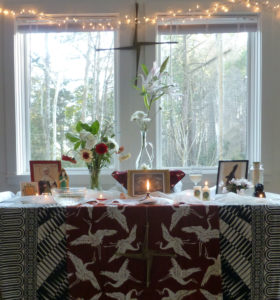
The seasonal Celtic rite of Imbolc is about preparing, purifying, and healing. It expresses ancient and contemporary peoples’ hope for new growth — for fertility arising in nature, for creativity arising in us. This year Imbolc coincides beautifully with our new-found hope for healing our bodies from disease, our social divisions from racism, and our planet from destruction. The lovely young poet, Amanda Gorman, who read at the inauguration of our new President, said she wanted her words to “re-sanctify a space . . . that had been violated” and “re-purify this idea” of our country.
Imbolc has traditionally been a time for re-sanctifying and re-purifying. At Earth Sanctuaries the symbolism of Imbolc inspires us to create celebrations to re-sanctify the land — the plants and animals of our local sacred places — and ceremonies to re-purify our souls through strengthening our relationship with spirit-filled nature at this potent time. We celebrate Imbolc, with its mythic emphasis on inspiration and creativity, exuberantly, through multi-media images and story, crafts and ritual, song, dance, and live music.
No one knows how long ago Imbolc originated. But a 3500BC burial cairn in Ireland might hold a clue and link us back in ancestral time. On Samhain the rising sun entered the passage of a cairn on the “Hills of the Hag.” Striking a tall limestone pillar, it proclaimed to the Neolithic peoples the beginning of winter. On Imbolc it shines in again, illuminating the stone, and signifying the end of winter, the beginning of spring. The Hag’s time, the Cailleach’s time, had begun on Samhain, October 31. On Imbolc, February 1st, Brigid,1 the young maiden goddess, once again brings the beginning of the bright half of the year to all of nature.
To Banish Winter
At Imbolc, the earth begins to awaken from its winter sleep. The sun that was reborn anew at Winter Solstice has begun to grow noticeably stronger. By Imbolc we have a full hour more of daylight. In the woods, the seeds that nature sowed in autumn begin to stir. In the garden the birds have begun singing again. It is time to plant the early peas. All around us we can sense new growth about to spring forth. We are waiting. We are preparing for nature’s potential to emerge and be fulfilled. We are part of this Mystery of the rebirth of life. Imbolc is a festival of fertility, like a seed that is fertile and full of life, but that life is still hidden within. Our own fertility quickens with hope. We are swelling in the belly of the Earth Goddess. It’s a time of preparation, for making ready a fertile garden and a fertile mind for imagining new ideas, new solutions. In the womb of Mother Earth, hidden from sight, there are stirrings.
Imbolc means “in the womb” of the Mother. Milk is swelling in the breasts of the ewes to nourish the new lambs about to be born. During this season of preparation, the agricultural tools are being cleaned and consecrated, made ready for their work of preparing the fields. The new seeds are sorted and blessed for planting, when it’s time. We participate in the birthing, the great awakening and revivifying of the Earth.
The ancients carried torches through the fields to purify, protect and prepare the soil. Perhaps this was a symbolic remnant of actual burning. We are regaining indigenous knowledge of the importance of burning to prepare the ground, to fertilize the soil with the mineral-rich ash.2 They also carried torches at this time to look for Persephone to re-emerge from the underworld, so the land could be fertile and flower again. These folk-rites of purification, like ancient torchlight ceremonies or traditional candlelight processions around the fields to bless the land, became observed in Christian Europe as Candlemas, February 2nd. Candlemas is richly entwined with Brigid and with her sacred animals.
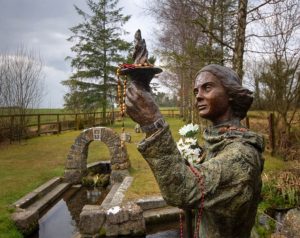
To Divine the Weather
When winter was colder and longer, and people had to count on what they had stored up for survival, for themselves and their livestock, it was crucial to determine when winter was half-over. Imbolc is halfway between Samhain, the beginning of winter’s time of rest, and Beltane, when it was time for planting to begin. So Imbolc was a good time to assess the weather.
In Scotland Imbolc was when the Divine Hag, the Cailleach, was said to gather up her firewood for the rest of winter. If she wants to make winter last longer, she will arrange for the day to be bright and sunny, so she can gather up lots of wood. If Imbolc is dark and dreary it means that the Cailleach, thank goodness, is sleeping in, and winter will soon be over.
Although it seems curious to us now, all over Europe there was a long tradition of sayings like, “As the sun shines on Candlemas Day spring will be far away. If it’s not shining, spring will be early.” An old British rhyme tells us, “If Candlemas Day be bright and clear, there’ll be two winters in the year.” In Germany it went like this, “As the sun shines on Candlemas Day, so will the snow swirl until May. As the snow blows on Candlemas Day, so will the sun shine before May.” A rural folk verse from Appalachia says, “February 2nd, Candlemas Day, half the grain and half the hay. Half the winter is passed away. We eat our supper by the light of day.”3 The wisdom is that if you have half of your food and firewood left at Candlemas you will be able to get through the rest of the winter.
Wait a minute, how did the groundhog get in on this?
To Honor Her Animals
At Imbolc we, at Earth Sanctuaries, celebrate not only the mythic, spiritual story of the season, but also the story of wild nature, the plant and animal kin with whom we share the land. Imbolc is a story of the Divine Feminine. She is mistress of the animals. World-wide, goddesses are associated with animal companions and familiars. Brigid is associated with many animal companions. Honoring her animals gives us an opportunity to honor many of our own. Swans, snakes, wolves, bears, groundhogs even, are part of her story and they are part of our story, the story of our sacred wildlands. We have learned from both the pandemic and from climate change how crucial it is that we protect animals and their habitats in the wild. We know that to restore the wild, we must also re-story the wild, tell its sacred story.
The archetypal theme of death and rebirth is reflected by hibernation and re-emergence, which are metaphors for the life-death-rebirth process as symbolized by Snake and Bear. And, thus, for the renewal of nature and of our souls.
Snake: The snake is a symbol of wisdom. It sheds its old skin, but it doesn’t die, it is reborn. Snakes hibernate. There is wisdom in darkness, waiting, stillness, reflection. On the first day of spring in Scotland people looked for snakes, adders, to re-emerge from their holes. An old Scottish chant is translated as,
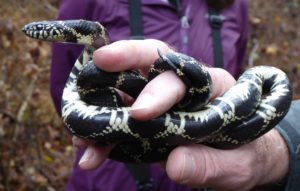
Early on Brigid’s morn
the serpent will come from the hill.
I will not harm the serpent.
Nor will the serpent harm me.
Bear: In ancient times there were Bear Cults in France, Hungary, Austria, and Germany where hibernation was symbolic of death/rebirth, of the mysteries of regeneration. Originally it was an old European tradition that if the sun shone on Candlemas Day a bear would cast a shadow, thus predicting six more weeks of winter. The German saying went, “When the bear sees his shadow at Candlemas, he will crawl back into his hole for another six weeks.” Later, Germans watched a badger or hedgehog for a shadow. What these animals have in common is that they hibernate. February 2 is still Bears’ Day in some places in Europe. When bears became extinct in most of Europe in the 11th century, they were replaced with badgers.
Groudhog: When the Germans came to Pennsylvania there were no badgers, so they replaced them with the groundhog. Groundhogs go into the earth to hibernate. Hibernation is symbolic of death. Earth contains the mystery of death and transformation. Some Native Americans see the groundhog as an intermediary between mother earth and father sky because they spend half their life underground and then emerge, rise up into the sun’s light, and whistle like an eagle. American Indians made sacred food from its flesh, moccasins and medicine drums from groundhog hides. To the Cherokee groundhog is an important medicine animal because of its knowledge of herbs and healing plants. If you were to watch one around your home, you would see it eat clover, dandelion leaves, plantain leaves, wood sorrel and violet leaves.4
To Transform By Fire
The Goddess herself is changing. As weather goddess, the Cailleach, crone of winter, transforms to Brigid, the young maiden of spring. Brigid is a pan-Celtic goddess. In Ireland she is the triple goddess of the magical race of the Tuatha de Danaan, the daughter of the Dagda, the god of abundance. She is the goddess of poetry, smithcraft, and healing. Poetry requires the fires of inspiration and prophesy for otherworld visioning. Smithcraft uses the fire of the forge to transform raw materials into refined tools and objects of beauty. Fire purifies water for healing and for birthing. Fires warm our inner vital energies.
St.Brigid is one of the three patron saints of Ireland, along with Patrick. Known as a uniter, in the 6th century she founded a double monastery, for women and men equally, in Kildare, Cil Dara, the Church of the Oak, near a Druid grove. St.Brigid continues to embody many of the attributes of goddess Brigid. In countless legends she is associated with fire — at her birth the house shines with light as if on fire; she hangs her cloak upon the rays of the sun.
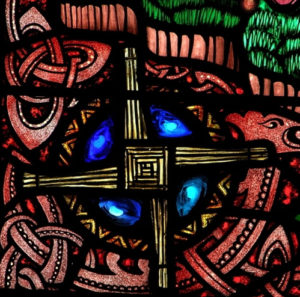
To this day her sanctuary contains her original fire temple. We are told that Brigid and her nineteen priestesses, er nuns, kept the fire continuously burning. After her death, each sister of the flame took turns tending the fire for nineteen nights. On the twentieth night it was kept lit by Brigid herself. Thus, the sacred fire was kept burning through the centuries. Her new center in Kildare is called Solas Bhríde, the Flame of Brigid. When we visited there, the Brigidine Sisters, Mary and Phil, blessed us with a candle lit from her eternal flame. The sisters told us they don’t make a distinction between Brigid and St.Brigid. When we told them we had seen a certain example of the miraculous workings of Brigid one of them said, “Now isn’t that the rising of the feminine!” Scratch the ground in Ireland and you find the Divine Feminine. It has been suggested that we simply call Brigid “holy woman” instead of goddess or saint.
The Celtic day began at sundown, so the eve of each of the cross-quarter festivals is within that liminal time when magic can happen. At her birth, St.Brigid’s mother had one foot inside the door and the other outside. It is on the eve of her feast day that the Brigid’s crosses and other preparations for her arrival are made. During the night Brigid passes by and blesses the fields, the animals, the home, the community.
Our Imbolc Celebration and Ceremonies
Please Join the Celebration:
Pilgrimage As participants arrive we are greeted with the purifying fragrance of a juniper (cedar) smudge. Imbolc, the Festival of Brigid, is the time when the energies of spring are first stirring. We are here to help awaken and bless the new life quickening in the land. The very earliest woodland flowers have just begun to bloom, and the birds have started their morning songs. Traditionally, this is a time for purifying and preparing the land, and ourselves, for the emergence from hibernation of new life. Our symbolic pilgrimage gives us the opportunity to welcome back the sun and call to the earth spirits, sprinkling offerings of birdseed and milk in gratitude as we walk.
We are led in a visualization to prepare ourselves, to open our hearts and expand our embodied souls to enter the Field of Divinity. We’ll walk in silence. We may think of a question about what wants to arise in us to carry with us on our walk, as we open to noticing and receiving a message from nature in response. We are “walking our prayers,” blessing the sacred landscape, which is permeated with spirit, with love.
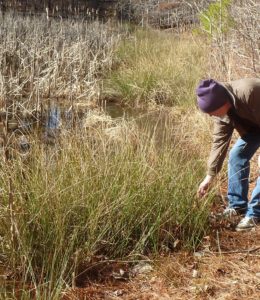
Often the weather is a perfect combination of wintery enough for this celebration of welcoming the return of the sun, yet warm enough to make lovely the pilgrimage through the woods to the pond, with torch fire and the beat of a lone drum. Arriving at the pond, we pick native rushes along the water’s edge to later weave our prayers into Brigid’s crosses. It is traditional to pull, not cut, the rushes, perhaps because cutting the rushes would expose them to iron, which is anathema to the fairy spirits. We make little magnolia-leaf boats to float offerings of flower petals, fruits, seeds for the birds and oatmeal for the fish, to express our gratitude and to invoke protection for the Cape Fear watershed of which this pond is a part.
Opening Fire Ritual Returning from the pilgrimage a bit cold, we are grateful to gather around a warm fire. We watch as the last of the evergreens left over from the Yuletide season crackle and burn to banish winter and welcome spring. We call the Directions with singing and circle dancing and invite the powers of the Elements to join us.
Purification at the Elements Altars As pilgrims on our way to Brigid’s Shrine, we make our way to the four elements altars to bless ourselves and the elements of all life. The community has lovingly decorated the altars. A card on each table suggests that we make gestures of purification and element-honoring. This is a much favored activity, so we are content to wait our turn in contemplative silence.
The Earth Altar is draped in cloths of green, with twining leaves and bright daffodils. There is a large bowl of black soil and a small bowl of pea seeds. Bless and purify by touching sacred soil, composting any toxins and nourishing your body. You may plant a seed to represent making a commitment to some way in which you will nurture the Earth in this new year.
The Air Altar is clothed in fabrics of yellow and gold, decorated with many feathers. There is a dish of cedar and various other powdered incenses. Bless and purify with incense, blowing away heaviness and freeing your spirit. You may send your prayers for all of life up to Great Spirit, sprinkling Grandmother Cedar on the burning charcoal, and fanning the smoke with a chosen feather.
The Fire Altar is arraigned in shiny, shimmery reds, topped with a golden sun. There is a ring of candles lit from Brigid’s Flame at Solas Bhride, a cauldron, pencils and strips of paper. Bless and purify with sacred fire, burning away darkness and illuminating your love. You may write down an obstacle to your passionate Good Work that you want to release to be transformed, burning it in Brigid’s Flame.
The Water Altar is swathed in blues and whites. There is a bowl of holy water, a shell to dip from it, and small bowls of creek water and pebbles. Bless and purify with this sacred water from Brigid’s Holy Well, washing away muddiness and refreshing your emotions. You may imbue these colored pebbles with your prayers for our watersheds. Drop them into these pools and they will find their way back to New Hope Creek.

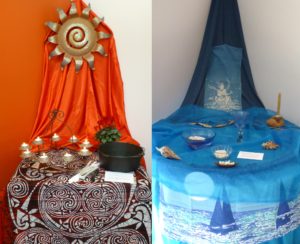
Craft-Making Crafts provide an opportunity to “make our prayers.”To not only say our prayers with our minds, but to make our prayers with our bodies, to infuse our prayers into the symbolic hallowed objects of Imbolc. Some of these crafted items, in turn, will help us live deeper into the season in the ceremony that will follow.
Birdseed mandalas: We impress designs of different colored bird seeds onto peanut butter-covered rounds of wood, and hang these on a sculptural Tree of Life, infusing them with our prayers, as offerings to the winged ones and spirits of air, and to invoke the goddess as mother-protectress of the animals. Later we will take them home to feed the birds of our gardens.
Candles: At Candlemas the people of old Europe made candles for the coming year. We, too, make candles, melting down our old ones, re-making the new. We ritually burn the candle to burn away shadow. Shadow is what is unlived, but projected out onto others, and envied or disliked. We burn away that which is darkness in us, covering up our light. We burn the candles for what we want to bring light to, or for what we want to bring into the light. We decorate shimmering candle cups that will later receive Brigid’s flame on a spinning sun-wheel.
Brat Bhríde, Brigid’s Mantle: The tale is that when St.Brigid asked the High King of Leinster for land for her convent, he said, begrudgingly, no doubt with a smirk, “Sure, you can have all the land that your cloak can cover.” When she laid it on the ground, it billowed out and spread for miles. These are the vast, sacred, protected grasslands of the Curragh that are still held in common. When in Ireland we gathered rushes on the Curragh to make our Brigid’s crosses. This is her mantle of protection, her mantle of greening earth. Have you smelled clothing that has come in from outdoors? This is the sweet fragrance of the Mother. It is traditional to leave a piece of cloth out overnight to be imbued with curative power as Brigid passes by. It was placed on the body for ritual healing. Some of our participants have left out cloths for the Mother to bless. They give strips of them to us to be worn as protective amulets or used as traditional ribbons of healing. A large green shawl was left out, draped on a bush overnight, to be infused with Brigid’s blessing and used in the ceremony.
Cros Bhríde, Brigid’s Crosses: The legend is that Brigid converted a pagan king on his deathbed by picking up rushes strewn on the floor and fashioning a cross, while telling him the Christian story of light and love. As we weave our rushes we turn them. They look like solar wheels turning. Whether goddess of fire or saint of sunlight, we align ourselves with the transformative flame of Brigid. Some crosses will be taken home to bless and saine the house and hang over doors for protection, as is the folk custom. Some will be attached to the Brigid’s Belt that we make for the ceremony. It is traditional to sprinkle them with holy water. Here I am dipping a newly made Brigid’s cross into the Well of Youth on the holy isle of Iona, Scotland. Fire and water, water and fire. There are hundreds of holy wells of Brigid.
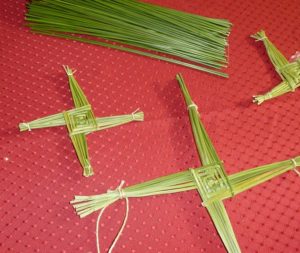
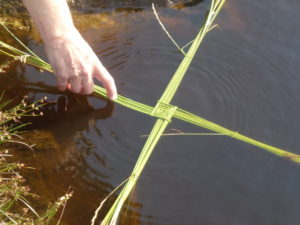
Crios Bhríde, Brigid’s Belt: The Crios Bhríde is a large hoop made of plaited straw with three, sometimes four, Brigid’s crosses attached. We braid three ropes and attach our Brigid’s crosses. Traditionally at Imbolc, the youth of a village would carry St.Brigid’s Belt to each house. Three times the hoop was passed over each member of the family, and they would step through it, while the others chanted a blessing for Brigid’s protection and good health in the coming year. A Celtic body-based prayer of protection is called a caim. At a Brigid’s Church in Ireland the suggested blessing was itself a circular chant: Oh, Sacred Three my protection be, encircling me, my life, my home, my family; encircling us, our protection be, Oh Sacred Three. We will share this ritual in the ceremony.

Brideóg, Little Brigid: These are small effigies of young Brigid, often made from a sheaf of oats or wheat, called corn dollies, or from a bundle of green rushes. Traditionally, she was carried from house to house to announce the arrival of the holy one. In some places the dolly was dressed and laid in a basket to sleep in the house. In other places she was stood at the threshold of the door, to invite holy Brigid to come spend the night. A leader teaches us to make delightful brideógs of colorful cloths. She is inspired to make a larger, ethnically-colored one. We lay her in a basket to wait for the ceremony.

Images and Story
Holy Woman We take a break to get hot cider, then gather for stories, illustrated with slides. We see Brigid’s center, Solas Bhríde. Dedicated to peace, the center holds a large, yearly peace conference. Images show the powerful appeal of Brigid as a uniting figure who brought (and still brings) together Pagans and Christians, Catholics and Protestants, men and women, sacred and secular, spirit and nature, animals and humans. For example, we are told in the legends that her mother was a slave, her father a rich chieftain. Thus she also bridges rich and poor. Oh how we need new uniting figures!
Sacred Landscape In light of the ecological crises we face, we view images of the Sacred Landscape, extending from 3000BC to the present, in hopes of renewing our vision of the land as the Body of the Mother. We learn the story of Brigid as the Celtic Divine Feminine in the context of the mythic Irish landscape, where there is a great resurgence of the compassionate power of the feminine.
We see images of her ritual landscape with her sacred wishing trees with their offerings and prayer ties. We see her holy wells, which honor and protect fresh waters as sacred and healing. We see her fire temple and the perpetual flame, and the sacred grasslands of the Curragh, Brigid’s green mantle. We hope that our lands and waters here, now, can be seen as sacred, the body of Mother Earth. We hope that someday the Divine Masculine will arise to love and protect Her.
Sacred Animals We honor in images and story Brigid’s totem animals, in the context of honoring our own wild kin. We celebrate Brigid in her aspect as White Swan while telling about the mythic migration of our own native tundra swans to and from our coastal refuges. Swans are associated with Brigid because they arrive back to northern lands in large numbers near Imbolc. Often goddess totems, swans mate for life and are the very embodiment of hope, peace, and love. We show the Wild Swans video we made of our coastal birds while playing our friend Cynthia Crossen’s Wild Swans 5song. Here is our story of pilgrimage to see them. We may weave white feathers into our Brigid’s crosses.
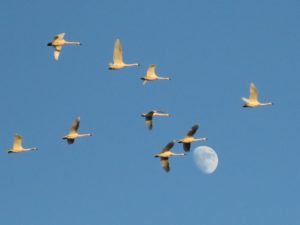
We see an image of Brigid with a wolf. Wolves are often pictured beside Brigid as protectress of the wildest wild. Not in Ireland, though, because they went extinct there too long ago to remember. We are now in a crucial time of fighting for the very last of our wild red wolves. They once roamed the entire country east of the Mississippi. They were the wolf of the east. Most of us have forgotten they ever existed. Now they are down to only about fourteen. These last wild wolves are right here on our coastal plain. We have been grateful to see a wild wolf on one of our trips to the Alligator River National Wildlife Refuge. Yet they are not being protected as an endangered species. No doubt Native Americans have held red wolves sacred and told stories about them. We better re-purify our ideas about wolves and start re-sanctifying them real soon.
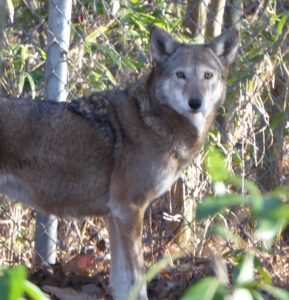
Bears are often associated with the goddess. Sometimes she is depicted as the Bear Mother nursing the divine child. Bears in our mountains are hibernating now. Bears on our coastal plain are denning and giving birth. Here is a magnificent male black bear at Pocosin Lakes NWR. Every winter we make a pilgrimage to see them. We honor our native bears, for which we are so thankful. We honor the Spirit of Bear, which preceded the groundhog, as symbols of hibernation and emergence into new life.
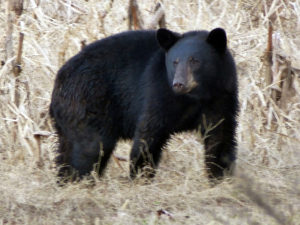
Please Join the Ceremonies:
The Blessing of Hibernation
Groundhog Day is our last remnant of the old European bear cults in which hibernation was a metaphor for the spiritual journey.6 As the bear has a shadow, we have a shadow, our dark side. If we enter the darkness, as the bear enters the cave, we may be able to heal. But if we emerge too soon, our shadow still attached, we must go back into the earth “for six more weeks” until purified. Hibernation has always had great spiritual significance. Through fasting in isolation, one could enter conditions of trance. Hibernation symbolizes being able to surrender the separate ego-self, to die without dying, and emerge reborn, knowing our oneness with all of life.
We are led in a guided meditation into the silence and darkness of the cave of our hearts. There we journey to the Bear Mother where we imagine being held in such compassion, with such love, that we are able to surrender to her some of the pain that we had hidden away in the shadow, thinking it unacceptable. When we have been snuggled enough, we emerge into the light, knowing that all our feelings are valid. And knowing that we can always go back to her for more holding.
The Blessing of Spring’s Greening
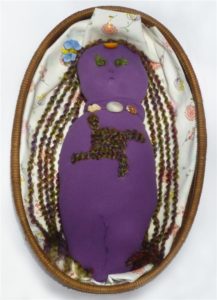 A young woman, representing maiden Brigid, reads her lovely poem called The Greening Time, accompanied by guitar. I, as crone, put Brigid’s mantle over my head and speak as the Cailleach, giving over winter to young Brigid, “Behold I am the Cailleach, Crone of Winter, I am losing my strength. I thirst.The first ray of sunlight is on the water. I go to the Well of Youth to drink. . . . I am reborn! Cailleach gives the beautiful ethnic Brideóg doll in her basket to the maiden. As Maiden of Spring young Brigid receives the Brideóg from Cailleach, thus celebrating the power in each of us to constantly shapeshift between our old wisdom and our young passion.
A young woman, representing maiden Brigid, reads her lovely poem called The Greening Time, accompanied by guitar. I, as crone, put Brigid’s mantle over my head and speak as the Cailleach, giving over winter to young Brigid, “Behold I am the Cailleach, Crone of Winter, I am losing my strength. I thirst.The first ray of sunlight is on the water. I go to the Well of Youth to drink. . . . I am reborn! Cailleach gives the beautiful ethnic Brideóg doll in her basket to the maiden. As Maiden of Spring young Brigid receives the Brideóg from Cailleach, thus celebrating the power in each of us to constantly shapeshift between our old wisdom and our young passion.
We are led in dancing Peaceful Steps, singing words from Thich Nhat Hanh, May I take peaceful steps upon the earth … I bow to you, a flower. Singing softly, we walk mindfully, taking peaceful steps around the room. On “I bow to you,” young Brigid gives the Brideóg doll to someone near, who then gives it to her neighbor on the next bow. We are passing the blessing of spring from one to another as, traditionally, the Brideóg was taken from house to house, bringing Brigid’s blessing of the arrival of spring.
The Blessing of Empowerment
Three leaders stand as priestesses at the beautiful Brigid’s Shrine. One holds a bowl of Brigid’s sacred healing waters. A second holds a flickering Brigid’s candle. The third holds the green shawl that is Brigid’s mantle, infused with the dew of her passing spirit. Participants begin a silent ceremonial procession to the Shrine, accompanied by the soft, meditative sounds of a lone guitar. As each arrives at Brigid’s Shrine, she receives from the water bearer a sprinkled blessing, with the words, May you be healed and refreshed in body, mind, and spirit from the wellspring of the Great Mother. She is then circled with light by the bearer of the sacred flame of inspiration, who says, May Brigid’s flame illuminate your heart. She is then wrapped by the bearer of Brigid’s mantle who places it around her, speaking this blessing, May you be held and protected under the mantle of the Great Mother. For some of us this brings tears. We may choose to whisper back our commitment to a new undertaking, for which we seek blessing.
The Blessing of Protection
This has been an especially hard year with pandemic, racism, and threats to our democracy. Many of us have felt a lot of fear. We each have the ability to make a creative response for healing, for peace. We recognize that in order for our unique contributions to emerge, we need to feel safe, or at least safe-enough. So, for this ceremony we learn a caim, a Celtic Christian body-based prayer to call upon the energies of the Sacred Three to encompass and enfold us. We gather into three groups, each with a braided Brigid’s Belt. We hold it for each other, as the Crios Bhríde is made to encircle each of us in a ritual of blessing and protection. , Three times the Brigid’s Belt is brought down over each of us, blessing us from head to toe, while the group chants the caim of protection: Oh Sacred Three, my protection be, encircling me, my life, my home, my family; encircling me, my protection be, Oh Sacred Three. The chant itself is a circle of protection around us.
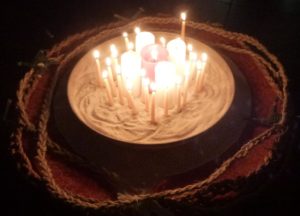
Returning, and standing in the full circle, we turn to face each of the Four Sacred Directions as we chant another traditional caim that we have adapted, adding the Elements, and changing Lord into Love:
East, Air: Circle me, Love, Keep hope near and doubt afar.
South, Fire: Circle me, Love, Keep light near and darkness afar.
West, Water: Circle me, Love, Keep peace near and fear afar.
North, Rock: Circle me, Love, Keep protection near and danger afar.
Singing together, we dance a final circle dance: Round and round we go, we hold each other’s hands; Weave our lives in a circle; Our love is strong, the dance goes on.
Feasting and Finale
We end the ceremony, closing the Directions and thanking the many leaders and participants for their contributions. After a potluck feast, accompanied by live Irish music, we light the shimmering candle-cups from Brigid’s Sacred Flame. As we place each one on the fire-wheel, the light grows brighter and brighter until, finally, the central candles are lit and the fire-wheel is spun to welcome the returning Sun. Gathering around the blazing sun-fire-hearth, we call upon Brigid as Goddess of the Light of Inspiration, and share our talents through an evening of poetry, story, music and song.
Addendum: As I am writing this I receive in the mail, synchronistically, an article about how certain endangered species have been saved by peoples of the world who hold these species sacred. One example given is the European brown bear, which is being saved from extinction in Romania, while it is dying out elsewhere. This is because it has been honored for centuries as connected with a deity who at birth was blanketed with a bear skin. He lived for long periods in an underground cave, only emerging occasionally to teach. The brown bear represents courage, power, death and resurrection. It is associated with healing. The most important “days of the bear” are February 1-3. The article concludes that affirming the sacredness of species is a necessary step to protect wildlife.7 Amen. May we learn to re-sanctify our animals and re-purify our relationship with our sacred lands.
Text © 2021 Betty Lou Chaika. Photos © 2020 David Chaika
Except stained glass Brigid’s Cross is from a window ‘St. Brigit,’ 1947, by Harry Clarke in St. Brigid’s Church, San Francisco.
Glowing fire-wheel taken by Sandra Brooks-Mathers.
Notes:
- Whether spelled Brigit, Brigid, Bhrighde, Bhríde, or Bride, all are pronounced Breed.
- https://en.wikipedia.org/wiki/Native_American_use_of_fire_in_ecosystems
- Doug Elliott, Wildwoods Wisdom, Encounters With the Natural World, NY: Paragon House, 1992. My gratitude to Doug Elliott who was the one who got me started on doing these Imbolc celebrations in the first place, back in 2004.
- Elliott—-
- Listen to Wild Swans (c)2000, by Cynthia R. Crossen – here.
- Elliott —
- Bungetti, G. and Bhagwat, S.A., “Sacred species and biocultural diversity:applying the principles,” P369-7 and P381-383, in Sacred Species and Sites: Advances in Biocultural Conservation, Gloria Pungetti, Gonzalo Oviedo and Della Hooke, ed., Cambridge University Press 2012.
Donna D
Beautiful. It’s a gift that you are documenting your rituals for others to use. I am happy we are half way through winter!
Betty Lou Chaika
Thanks, Donna. Yes, now I will just have to create new ones!
Azima Lila Forest
This is so beautifully done! I love these seasonal celebrations, and i have learned so much more about Imbolc from this. Thank you so much!
Betty Lou Chaika
Azima, you’re very welcome! I’m so glad you enjoyed reading this. I wish you much nourishment from the Mother, as winter transitions to spring.
Perry
We are at the beginning of a new time 2021, a new age, and a time of hope. Our President may declare the Climate Crisis a national emergency. And so I read this beautiful narrative of Imbolc with the image of the swan, a time of hope for all the earth. Perry
Betty Lou Chaika
Perry, yes, President Biden brings us hope, for the first time, that we might actually take action on climate change. And both the living presence of the swans and the beautiful images of Swans are lovely signs of hope!
Susan Baylies
I will be sharing your wisdom with our Eno River CUUPS ( Covenant of Unitatrian Universalist Pagans) group tomorrow by Zoom. Thank You, and Blessed Be for your thorough research and profound reflections.
Betty Lou Chaika
Susan, I’m glad you have found the story to be helpful to your own ceremonial work. I’d love to hear what you found most interesting and how you wove it into your gathering.
Mariah Wheeler
Exceptionally inclusive and beautiful. Thank you Betty Lou!
Betty Lou Chaika
And thank you, Mariah, for all the beauty you create and share!
ann loomis
I love it that my mother and great niece were born on Jan. 31/Feb. 1. While my mother has since passed into the spirit world, my great niece is a young girl who enjoys braiding her long blond hair . Thus, for me, St. Brigit is a personal symbol of the bridging of the generations, and her cross is a symbol of the interweaving of the worlds. One ritual that my husband and I do every year on Feb. 2 is to watch the Bill Murray movie “Groundhog Day” as a way of honoring our shadow material. What patterns need to shift so that we don’t mindlessly repeat them? Thank you, Betty Lou, for writing this informative piece and for including those wonderful images along with some creative ideas for new rituals!
Betty Lou Chaika
Ann, you are very welcome! It’s sweet to hear that you have an inter-generational connection of Imbolc with women you love. If there is one thing that Imbolc celebrates, it’s the Divine Feminine! Thank you for highlighting Brigid’s Cross as an image of interweaving the worlds. Yes, it’s been a time for me to face some shadow stuff personally and for us all to do so politically.
LuAnn
I just found this site and absolutely love it. I live in a very secluded area in Alaska and have been interested in becoming closer to Mother Earth for some time now. This opens a lot for me. Thank you!